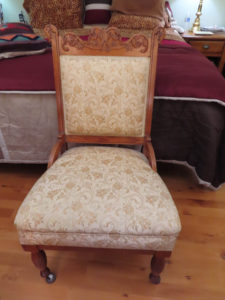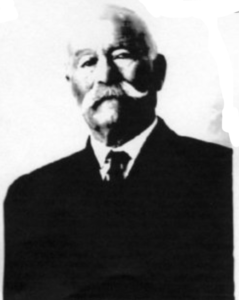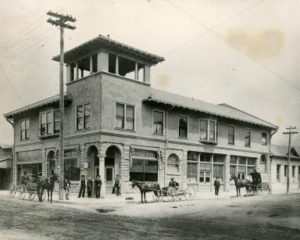 RM owns two Renaissance Revival chairs that carry significant Santa Barbara history. His family treasured then since 1906 when they purchased them as part of the original furnishings for the Nardi Hotel on the corner of Anacapa and East de la Guerra streets. RM’s great grandfather built the hotel in 1906. RM enlightened me with historical information on the hotel. I will tell RM that the style of these chairs ‘fits’ with the great respect his great grandfather possessed for cross cultural influences and the styles of the past! Read on to discover why…
RM owns two Renaissance Revival chairs that carry significant Santa Barbara history. His family treasured then since 1906 when they purchased them as part of the original furnishings for the Nardi Hotel on the corner of Anacapa and East de la Guerra streets. RM’s great grandfather built the hotel in 1906. RM enlightened me with historical information on the hotel. I will tell RM that the style of these chairs ‘fits’ with the great respect his great grandfather possessed for cross cultural influences and the styles of the past! Read on to discover why…
A building similar to the original Nardi Hotel exists on that corner although they tore down the original hotel in 1946. The original shape of the building lives on because the Nardi Hotel was created in the Italian Revival Style. The existing building was designed in the Spanish Colonial style. Both hearken back to a shared stylistic past founded in the Renaissance.
RM’s Great Grandfather
 The photo RM sent me of his great grandfather shows a proud man with a massive handlebar mustache in a dark wool suit. RM’s family has felt his presence for more than 120 years. Francesco’s wife was a descendant of a Spanish Presidio soldier, which made for an interesting marriage. When Francesco passed in 1944, the family owned both the hotel and the building across the street at 100-110 East de la Guerra. High taxes due to WWII necessitated of the sale of whichever building sold first. The hotel sold. RM’s father opened a business in the other building called Lloyd’s, which sold wines, spirits and fine foods from 1945-1972. This kind of fine wines and foods business also became a legacy from Francesco.
The photo RM sent me of his great grandfather shows a proud man with a massive handlebar mustache in a dark wool suit. RM’s family has felt his presence for more than 120 years. Francesco’s wife was a descendant of a Spanish Presidio soldier, which made for an interesting marriage. When Francesco passed in 1944, the family owned both the hotel and the building across the street at 100-110 East de la Guerra. High taxes due to WWII necessitated of the sale of whichever building sold first. The hotel sold. RM’s father opened a business in the other building called Lloyd’s, which sold wines, spirits and fine foods from 1945-1972. This kind of fine wines and foods business also became a legacy from Francesco.
RM housed his Law offices in that building until he recently retired. Next time you pass wave at the intersection, because it testifies to the intersection of cultures in the Presidio area in the early 20th century. Also to the spirit of non- Anglo early Santa Barbara entrepreneurs.
Early 20th century Santa Barbara History
 The Nardi Hotel housed a bakery and wine and grocery concern on the bottom floor. The family lived upstairs as well as offered guest accommodations. RM’s father grew up in the lively atmosphere of the intersection. A 1993 publication from UCSB and the Trust for Historic Preservation calls the hotel’s location a crossroads of action. A gang of Italian stonemasons lived in the hotel. Visitors to the family included extended Nardi family members, the former chief of police, and the fire chief. One block from Chinatown, looking from the windows people saw activity at City Hall and the jail.
The Nardi Hotel housed a bakery and wine and grocery concern on the bottom floor. The family lived upstairs as well as offered guest accommodations. RM’s father grew up in the lively atmosphere of the intersection. A 1993 publication from UCSB and the Trust for Historic Preservation calls the hotel’s location a crossroads of action. A gang of Italian stonemasons lived in the hotel. Visitors to the family included extended Nardi family members, the former chief of police, and the fire chief. One block from Chinatown, looking from the windows people saw activity at City Hall and the jail.
During those years, many residents of the Presidio area were Catholic, having roots in Hispanic, French, or Italian heritage. By the 1920s Anglo businessmen eyed the cheaper real estate in the area and bought property. Francesco became keenly aware of the nature of the neighborhood’s change. This effort by Francesco for our shared past carries a moral. One can exercise respect for tradition in tangible ways if they possesses the courage to buck a trend.
Spanish Colonial Vogue in Santa Barbara
Why the Presidio area changed under the watchful gaze of Francesco is a fascinating phenomenon in architectural style called the Spanish Colonial vogue. Businessmen outside the Hispanic culture actively removed the old adobes of the area and rebuilt in the Spanish Colonial Style. The real architecture of the Spanish past in Santa Barbara was rebuilt in a repacked romanticized version of the Spanish past. Developers turned a blind eye to Californio culture and rebranded it. Many old adobes were lost. Francesco mounted a campaign to save the Lugo adobe, the Miranda adobe, the adobe that abutted his hotel, and the Santiago de la Guerra adobe. He and his wife respected their shared past and the future of Santa Barbara as related to the Californios culture.
RM’s chairs fit with this ethos
The chairs styled in the Renaissance Revival tradition, hearken to the Italian Renaissance, a style popular in the late 19th to early 20th century. Even the furniture chosen for his hotel back in 1906 had Francesco’s taste and respect for the traditions and styles of the past. The value of the pair is $600, but the story they carry is irreplaceable.
I always get lost in your articles about the past and esp. santa b’s as it sure has some interesting stories. I’ll have to look at that corner next time I’m downtown.